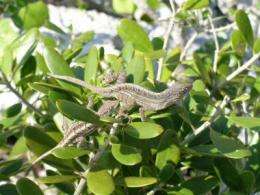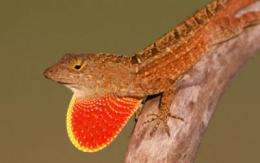Castaway lizards provide insight into elusive evolutionary process

A University of Rhode Island biologist who released lizards on tiny uninhabited islands in the Bahamas has shed light on the interaction between evolutionary processes that are seldom observed.
Jason Kolbe, a URI assistant professor of biological sciences, and colleagues from Duke University, Harvard University and the University of California at Davis, found that the lizards' genetic and morphological traits were determined by both natural selection and a phenomenon called founder effects, which occur when species colonize new territory.
Their research was published today in the journal Science.
"We rarely observe founder effects as they happen in nature, but we know that it happens because islands are colonized by new species over time," said Kolbe. "What we didn't know was how these evolutionary mechanisms interact with each other. What we learned is that the differences caused by the founder effects persist even as populations adapt to their new environments."
The founder effect is the loss of genetic variation that occurs when a new population is established by a very small number of individuals from a larger population. It often results in the new population becoming genetically or morphologically different from the original population.

The scientists randomly collected brown anole lizards from a large island near Great Abaco and released one pair on each of seven nearby islands whose lizard populations had been cleared by a recent hurricane. The source island is forested while the other islands have short, scrub vegetation. Previous research found that anoles living in forests had longer hind limbs than those found in scrub habitat. Lizards with longer limbs can run faster on the broad perches available in forests, while short-limbed lizards are more adept at moving on the narrower perches found in lower vegetation.
The scientists revisited each of the islands over the next four years to measure the lizards' limb length and collect tissue samples for genetic analysis. All of the new populations survived and increased an average of 13-fold in the first two years before leveling off.
"We noticed a founder effect one year after starting the experiment, which resulted in differences among the lizards on the seven islands," Kolbe said. "Some of the islands had lizards with longer limbs and some had lizards with shorter limbs, but that was random with respect to the vegetation on the new islands."
Because the structure of the vegetation on the islands differed from that of the source island, the scientists predicted that natural selection would lead the lizards to develop shorter limbs.
"Over the next four years, the lizards on all the islands experienced a decrease in leg length that is attributable to natural selection," Kolbe explained. "But those that started out with the longest hind limbs still had the longest hind limbs. The fact that the populations maintained their order from longest to shortest limbs throughout the experiment means that both founder effects and natural selection contributed to their current differences."
According to Kolbe, founding effects are rarely observed in nature, with most previous studies being conducted in the laboratory. "Ours is the first to study this process experimentally in a natural setting, and we were able to account for multiple evolutionary mechanisms through time," he said. "We manipulated the founding of these islands, but everything else about it was natural."
The next step in the research will be to determine how long the founder effects persist before other factors erase its signature.
More information: "Founder Effects Persist Despite Adaptive Differentiation: A Replicated Field Experiment in a Caribbean Lizard," Science.
Journal information: Science
Provided by University of Rhode Island



















